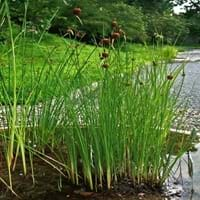Life Span
Biennial
Perennial
Origin
Texas
Eastern Europe, Western Asia
Types
Not available
Common Cattail, Southern Cattail, Dwarf Bulrush
Habitat
Forests, meadows, Pastures, Prairies, savannahs, Woodland edges
Lake margins, Ponds, Swamps
USDA Hardiness Zone
8-10
3-11
Sunset Zone
H1, 8, 9, 12, 13, 14, 15, 16, 17, 18, 19, 20, 21, 22, 23, 24
21,22
Habit
Upright/Erect
Upright/Erect
Flower Color
White, Lemon yellow, Light Pink
Yellow, Green, Brown, Chocolate
Flower Color Modifier
Bicolor
Not Available
Fruit Color
Tan
Light brown, Light Red
Leaf Color in Spring
Green
Green, Dark Green
Leaf Color in Summer
Green
Green, Dark Green
Leaf Color in Fall
Not Available
Green, Dark Green
Leaf Color in Winter
Light Green
Brown
Leaf Shape
Alternate
Long linear and narrow
Plant Season
Spring, Summer
Summer, Fall, Winter
Sunlight
Full Sun, Partial Sun
Full Sun, Partial Sun
Type of Soil
Loam, Sand
Clay, Loam, Sand
The pH of Soil
Neutral, Alkaline
Acidic, Neutral
Soil Drainage
Well drained
Poorly Drained
Bloom Time
Early Spring, Spring, Late Spring, Early Summer, Late Winter
Summer, Late Summer, Early Fall
Tolerances
Drought
Wet Site
Where to Plant?
Container, Ground, Pot
Container, In Water
How to Plant?
Seedlings
Runners
Plant Maintenance
Medium
Low
Watering Requirements
Average Water Needs, Do Not over Water, Keep the Soil well drained, Requires regular watering
Plant grows in water
In Summer
Lots of watering
Aquatic Plant
In Spring
Moderate
Aquatic Plant
In Winter
Average Water
Aquatic Plant
Soil pH
Neutral, Alkaline
Acidic, Neutral
Soil Type
Loam, Sand
Clay, Loam, Sand
Soil Drainage Capacity
Well drained
Poorly Drained
Sun Exposure
Full Sun, Partial Sun
Full Sun, Partial Sun
Pruning
Remove damaged leaves, Remove dead branches, Remove dead leaves
Prune in early spring, Remove damaged leaves, Remove dead branches, Remove dead leaves
Fertilizers
All-Purpose Liquid Fertilizer
Nitrogen, Phosphate
Pests and Diseases
Pests and diseases free, Red blotch
Red blotch
Plant Tolerance
Drought
Drought
Flower Petal Number
Single
Single
Foliage Texture
Medium
Medium
Foliage Sheen
Matte
Matte
Attracts
Bugs, Butterflies, Insects
Birds, Flying insects
Allergy
Abdominal pain, Anxiety, Inflammation, Low blood pressure
no allergic reactions
Aesthetic Uses
Beautification, Decorating walls, Hanging Basket, Showy Purposes, Used as an interior landscaping species, Used for decorating walls, fences, gates, hedges, etc.
Beautification, Showy Purposes, Water gardening
Beauty Benefits
Skin irritation, Skin Problems
Not Available
Environmental Uses
Air purification
Food for animals, Food for birds, Food for insects, Nesting sites for birds
Medicinal Uses
Eczema, Menstrual Cramps, Menstrual Disorders
Nutrients
Part of Plant Used
Flowers, Root, Seeds, Stem
Leaves
Other Uses
Beneficial species for attracting pollinators, deer resistant, Edible seed
Decoration Purposes, Showy Purposes, Used as Ornamental plant
Used As Indoor Plant
Yes
Yes
Used As Outdoor Plant
Yes
Yes
Garden Design
Mixed Border, Rock Garden, Wall, Wildflower
Bog Garden, Container, Water Gardens
Botanical Name
OENOTHERA mexicana
TYPHA minima
Common Name
pinkladies, pink evening primrose, showy evening primrose, Mexican primrose, and amapola.
Dwarf Cattail
In Hindi
Mexican primrose
बौना कैटेल
In German
Rosa Nachtkerze
Dwarf Rohrkolben
In French
Mexican primrose
Cattail nain
In Spanish
Primrose mexicana
Espadaña enano
In Greek
Μεξικού Primrose
Νάνος Cattail
In Portuguese
Mexican Primrose
Tifa Dwarf
In Polish
Mexican Primrose
Dwarf Ożypałka
In Latin
Mexicanus Primrose
Pumilio Cattail
Phylum
Tracheophyta
Tracheophyta
Class
Magnoliopsida
Liliopsida
Family
Onagraceae
Typhaceae
Clade
Angiosperms, Eudicots, Rosids
Angiosperms, Commelinids, Monocots
Tribe
Onagreae
Not Available
Subfamily
Onagroideae
Not Available
Number of Species
Not Available
Season and Care of Mexican primrose and Dwarf Cattail
Season and care of Mexican primrose and Dwarf Cattail is important to know. While considering everything about Mexican primrose and Dwarf Cattail Care, growing season is an essential factor. Mexican primrose season is Spring and Summer and Dwarf Cattail season is Spring and Summer. The type of soil for Mexican primrose is Loam, Sand and for Dwarf Cattail is Clay, Loam, Sand while the PH of soil for Mexican primrose is Neutral, Alkaline and for Dwarf Cattail is Acidic, Neutral.
Mexican primrose and Dwarf Cattail Physical Information
Mexican primrose and Dwarf Cattail physical information is very important for comparison. Mexican primrose height is 15.20 cm and width 25.40 cm whereas Dwarf Cattail height is 30.50 cm and width 45.70 cm. The color specification of Mexican primrose and Dwarf Cattail are as follows:
Mexican primrose flower color: White, Lemon yellow and Light Pink
Mexican primrose leaf color: Green
Dwarf Cattail flower color: Yellow, Green, Brown and Chocolate
- Dwarf Cattail leaf color: Green and Dark Green
Care of Mexican primrose and Dwarf Cattail
Care of Mexican primrose and Dwarf Cattail include pruning, fertilizers, watering etc. Mexican primrose pruning is done Remove damaged leaves, Remove dead branches and Remove dead leaves and Dwarf Cattail pruning is done Prune in early spring, Remove damaged leaves, Remove dead branches and Remove dead leaves. In summer Mexican primrose needs Lots of watering and in winter, it needs Average Water. Whereas, in summer Dwarf Cattail needs Aquatic Plant and in winter, it needs Aquatic Plant.





